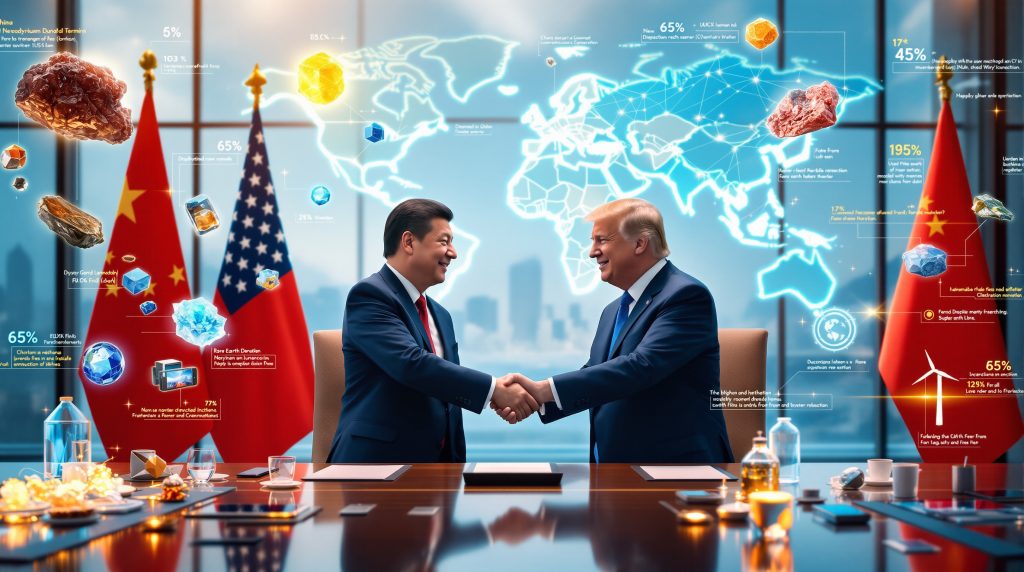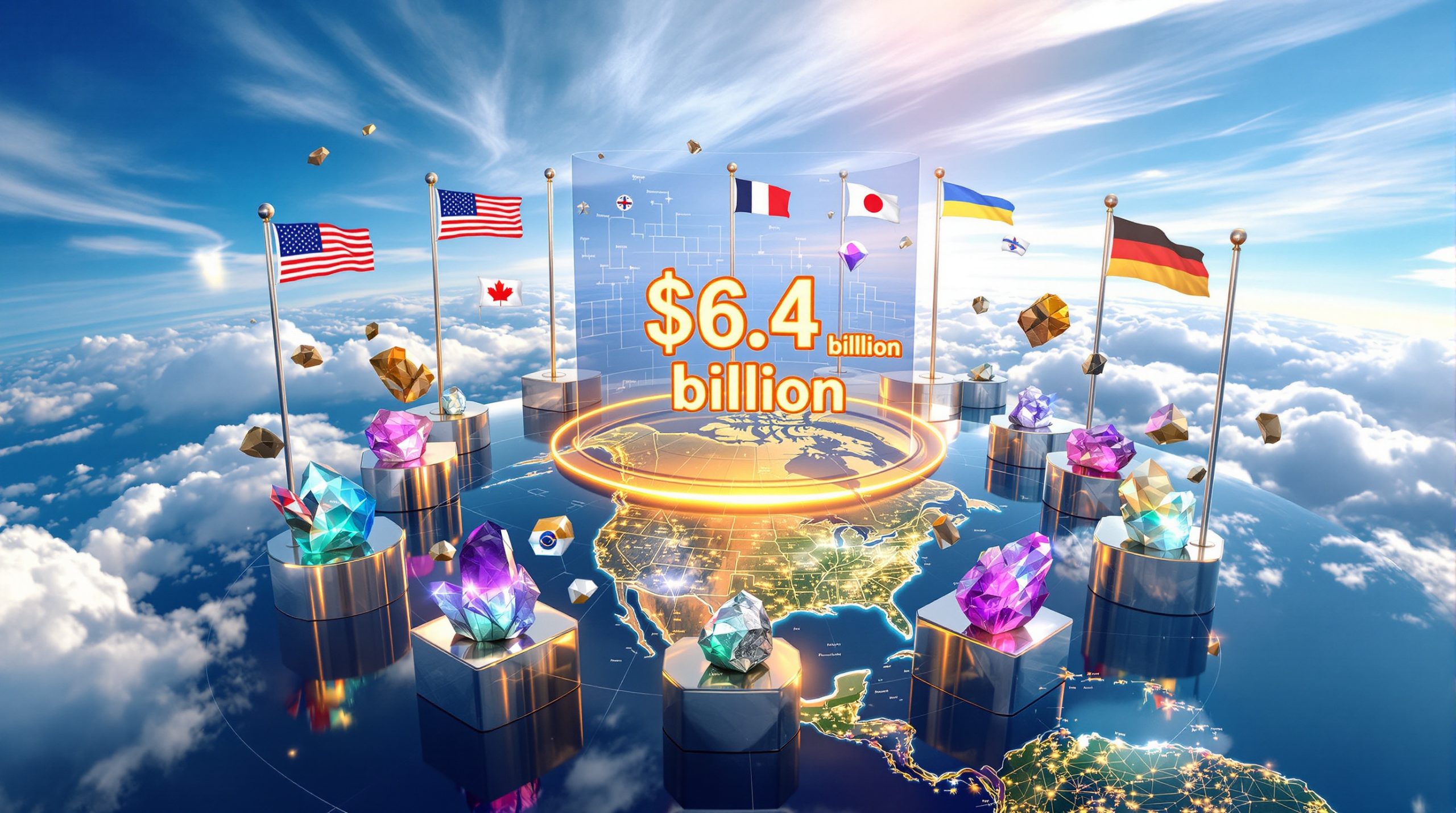Understanding the Strategic Mineral Agreement Between Superpowers
The Xi-Trump rare earth deal represents a pivotal moment in global supply chain diplomacy, establishing a temporary framework that addresses immediate tensions while exposing deeper structural vulnerabilities. This 12-month agreement, announced during the Busan Summit on October 30, 2025, creates breathing room for manufacturers while highlighting the urgent need for supply chain diversification and demonstrating how energy security trends continue to shape international relations.
Key Details of the Xi-Trump Rare Earth Agreement
| Agreement Element | Details |
|---|---|
| Duration | 12-month suspension period |
| Scope | Chinese rare earth export restrictions to US |
| Announcement Date | October 30, 2025 (Busan Summit) |
| Trade Context | Part of broader tariff reduction negotiations |
| Strategic Impact | Temporary stabilization of critical mineral supply |
The agreement's significance extends beyond bilateral trade relations, affecting global manufacturing networks dependent on these essential materials. For technology manufacturers, defense contractors, and clean energy companies, this temporary stabilisation provides crucial planning certainty while underscoring long-term vulnerability to supply concentration in a single nation.
How China's Export Controls Created Global Supply Chain Disruption
The Strategic Leverage of Rare Earth Dominance
China's commanding position as controller of approximately 90% of global rare earth supply transformed these minerals into powerful geopolitical instruments. When Beijing implemented export licensing requirements in October 2025, the ripple effects immediately disrupted international manufacturing networks across multiple critical sectors.
The implementation of these controls demonstrated how quickly strategic minerals can become tools of economic statecraft. Manufacturing facilities worldwide faced unprecedented uncertainty regarding material availability, forcing companies to reassess supply chain strategies that had operated seamlessly for decades. Furthermore, this development aligned with broader global mining trends that emphasise strategic mineral concentration.
"Critical industries including electric vehicle production, smartphone manufacturing, and defense contractors experienced immediate supply uncertainty, with manufacturing operations requiring rapid adjustment to licensing-dependent material flows."
Elements Beyond the Headlines: Strategic Limitations
The Xi-Trump rare earth deal contains significant exclusions that reveal its tactical rather than strategic nature. Understanding these limitations proves essential for assessing the agreement's actual impact on supply chain security.
Heavy Rare Earth Elements Remain Controlled
- Dysprosium and terbium licensing unchanged
- Samarium export permits still required
- Magnet-grade materials face continued restrictions
Processing Equipment Restrictions Persist
- Refining technology exports remain limited
- Separation equipment licensing unchanged
- Downstream manufacturing tools still controlled
These exclusions highlight the agreement's selective nature, addressing only October's incremental restrictions while maintaining fundamental controls over the most strategically important materials. This selective approach preserves China's leverage over critical supply chains despite diplomatic headlines suggesting broader resolution.
What Concessions Did Each Side Secure in the Busan Agreement?
America's Tactical Wins vs. China's Strategic Positioning
Comparative Outcomes from the Deal
| United States Gains | China's Strategic Maintains |
|---|---|
| 12-month export stability | Control over heavy rare earths |
| Reduced tariffs on agricultural products | Licensing authority over critical elements |
| Nexperia chip shipment clearance | Midstream processing dominance |
| Fentanyl cooperation progress | Long-term supply chain leverage |
The United States secured tangible short-term benefits through this transactional approach, obtaining immediate relief for manufacturers while addressing broader trade relationship concerns. The clearance for Nexperia chip shipments represents diplomatic pragmatism, though industry analysts suggest this gesture carries more symbolic than strategic significance.
Agricultural tariff reductions provide American farmers with expanded market access, demonstrating how rare earth negotiations interconnect with broader economic relationships. The inclusion of fentanyl cooperation progress indicates both nations' recognition that economic and security issues require integrated solutions. These dynamics reflect ongoing US‑China trade impact concerns that continue to shape global markets.
The European Union's Spectator Status
Brussels received diplomatic assurances rather than concrete supply guarantees, highlighting fundamental asymmetries in negotiating leverage. The EU's response characterising the suspension as appropriate and responsible masks underlying structural weaknesses in rare earth dependency.
Europe's exclusion from substantive negotiations reflects its lack of bilateral trade tools comparable to America's tariff leverage. Without significant transactional capabilities or alternative supply arrangements, the EU remains dependent on diplomatic engagement rather than economic bargaining power in rare earth discussions.
Why Europe was excluded from Xi-Trump rare earth negotiations: Europe lacks the bilateral trade leverage that enabled US-China negotiations. Without significant tariff tools or alternative supply arrangements, the EU remains dependent on diplomatic engagement rather than transactional bargaining power in rare earth discussions.
How Rare Earth Elements Power Modern Technology and Defence Systems
The 17 Elements That Define Technological Supremacy
Consumer Technology Applications
- Smartphone displays require europium and terbium for colour accuracy and efficiency
- Electric vehicle motors depend on neodymium and dysprosium for high-performance magnets
- Wind turbine generators use praseodymium and samarium for energy conversion
Military and Aerospace Dependencies
- Fighter jet guidance systems utilise yttrium compounds for precision navigation
- Missile technology requires specialised rare earth alloys for targeting systems
- Satellite communications depend on lanthanide elements for signal processing
The concentration of these materials in military applications creates strategic vulnerabilities that extend beyond commercial manufacturing. Defence systems require consistent material specifications, making supply disruption particularly challenging for military readiness and equipment maintenance.
"Advanced fighter aircraft contain substantial rare earth materials across guidance systems, communications equipment, and engine components, demonstrating the strategic vulnerability created by supply chain concentration in a single nation."
What Are the Long-Term Implications for Global Supply Chain Security?
Building Alternative Supply Networks
The temporary nature of the Xi-Trump rare earth deal emphasises urgent needs for supply chain diversification strategies that extend beyond diplomatic solutions. Multiple regions are developing alternative production capabilities, though meaningful capacity remains years away. In addition, initiatives like Australia's critical minerals reserve demonstrate national efforts to address supply security concerns.
Emerging Production Regions
- Australian mining operations expanding processing capabilities beyond extraction
- Canadian rare earth projects advancing through development phases
- African mineral deposits attracting international investment for exploration
Recycling and Alternative Technologies
- Urban mining from electronic waste streams gaining commercial viability
- Substitute materials research accelerating across industrial applications
- Circular economy approaches reducing virgin material dependence
Investment Opportunities and Strategic Risks
Rare Earth Investment Landscape Post-Agreement
| Investment Category | Risk Level | Strategic Considerations |
|---|---|---|
| Chinese rare earth stocks | Medium | Stable short-term returns, geopolitical exposure |
| Alternative supply projects | High | Significant development time, regulatory complexity |
| Recycling technologies | Medium | Growing market demand, technical challenges |
| Substitute material research | High | Revolutionary potential, uncertain timelines |
Investment strategies must balance immediate opportunities against long-term supply chain transformation. The 12-month agreement window provides time for alternative supply development while maintaining awareness of continued Chinese market dominance.
How This Deal Impacts Electric Vehicle and Clean Energy Markets
Stabilising Green Technology Supply Chains
The Xi-Trump rare earth deal provides temporary relief for clean energy manufacturers facing material cost volatility and supply uncertainty. This stabilisation proves particularly crucial for sectors experiencing rapid expansion while dependent on rare earth-intensive technologies.
Electric Vehicle Sector Benefits
- Motor magnet production schedules stabilised through reduced licensing uncertainty
- Battery material supply chains experience reduced pressure from export restrictions
- Manufacturing planning horizons extended for production capacity expansion
Renewable Energy Infrastructure
- Wind turbine production schedules secured through temporary material availability
- Solar panel component supply chains improved despite continued processing restrictions
- Grid storage technology development continues with reduced material constraints
The clean energy transition's dependence on rare earth materials makes supply chain security essential for climate objectives. This temporary agreement provides breathing room while highlighting the need for sustainable material sourcing strategies.
Strategic Lessons for Other Nations From This Agreement
The Power of Economic Interdependence
"The Xi-Trump rare earth deal demonstrates that even strategic competitors must balance geopolitical tensions against economic realities when critical supply chains are at stake."
The agreement reveals how economic interdependence can create pathways for cooperation despite broader tensions. Both nations recognised that supply chain weaponisation carries mutual costs, leading to pragmatic compromise despite strategic competition. However, according to recent reports, the deal's limited scope suggests continued underlying tensions.
Building Negotiating Leverage
Nations seeking supply chain security must develop comprehensive strategies that extend beyond diplomatic engagement. Effective negotiating leverage requires:
- Alternative supplier relationships reducing dependence on single sources
- Domestic processing capabilities enabling strategic material control
- Strategic material stockpiles providing negotiating flexibility
- Technology substitution programmes reducing critical material dependence
These capabilities take years to develop, emphasising the importance of long-term strategic planning over short-term diplomatic solutions.
Understanding the Xi-Trump Rare Earth Deal: Key Questions
Will this agreement prevent future rare earth supply disruptions?
The 12-month agreement provides temporary stability but doesn't address underlying supply chain concentration risks. Long-term security requires diversified sourcing, domestic processing capacity development, and strategic material reserves.
How does this deal affect rare earth market pricing?
Short-term price stabilisation is expected through reduced uncertainty, but long-term pricing will depend on global supply chain development, alternative source availability, and continued geopolitical relations between major economies.
What happens when the agreement expires in October 2026?
Both leaders indicated potential extension possibilities, but future negotiations will depend on broader trade relationship dynamics, alternative supply development progress, and evolving geopolitical considerations across multiple issues. As industry analysts note, the expiration timeline creates ongoing uncertainty for manufacturers.
Temporary Stability in a Strategically Volatile Market
The Xi-Trump rare earth deal represents pragmatic diplomacy addressing immediate supply chain pressures rather than permanent resolution of critical mineral dependencies. While providing crucial relief for technology manufacturers and clean energy sectors, the agreement underscores urgent needs for supply chain diversification and alternative source development.
For investors and industry stakeholders, this agreement creates a valuable 12-month window to advance alternative supply projects, develop recycling capabilities, and build strategic stockpiles. The temporary nature of diplomatic solutions in critical mineral markets reinforces long-term value propositions for supply chain independence and technological innovation.
The agreement's selective scope, excluding heavy rare earth elements and processing equipment, demonstrates that fundamental supply chain vulnerabilities persist despite diplomatic headlines. Industries dependent on these materials must continue developing resilience strategies that extend beyond temporary political agreements.
This analysis involves forecasts and speculation about geopolitical developments and market conditions. Supply chain dynamics, international relations, and material pricing can change rapidly based on numerous factors beyond the scope of this temporary agreement. Readers should conduct independent research and consult qualified advisors before making investment or strategic decisions.
Looking to Capitalise on Critical Minerals Market Opportunities?
The Xi-Trump rare earth deal highlights how geopolitical tensions create strategic opportunities in critical minerals markets. Discovery Alert's proprietary Discovery IQ model provides instant notifications on significant ASX mineral discoveries, helping investors identify actionable opportunities in the critical minerals sector before the broader market. Start your 30-day free trial today and position yourself ahead of supply chain volatility.




